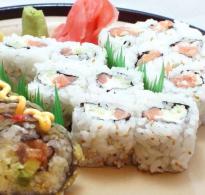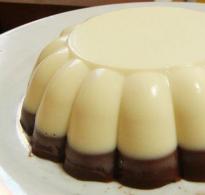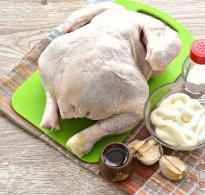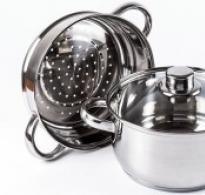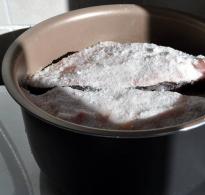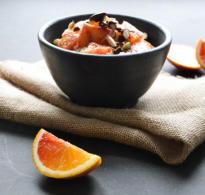How many calories are in fish, calorie content of dried, boiled, fried and smoked fish. We determine the calorie content of fish: what varieties can be eaten without harm to the figure
Calorie content of fish: 120 kcal. *
* average value per 100 grams, depending on the type of fish and the method of preparation
Fish is considered an essential food for diet food... Thanks to the beneficial properties of the product, the body is saturated with all useful nutrients. When losing weight, you should pay attention to less fatty varieties.
Nutritional value of sea and river fish
The highest nutritional value is possessed by sea fish, the calorie content of which varies from 100 to 300 kcal. These are trout, mackerel, herring, salmon, etc. Compared to river inhabitants, they have more saturated fatty acids. However, many trace elements are also contained in river fish with a calorie content similar in numbers to fruits and vegetables. This indicator directly depends on the amount of fat in the product.
With the regular use of fish, well-being significantly improves, strength and energy appear, blood vessels, nails and hair are strengthened.
The positive effect is due to the content in the product of omega-3 fatty acids, a large amount of minerals and vitamins. Lakes and rivers are inferior in terms of the number of nutrients (proteins, omega-3 acids, iodine and calcium) to ocean inhabitants and marine ones. The fattest include herring, salmon, halibut and mackerel (more than 8% fat), the opposite category - flounder, blue whiting, pollock, hake and cod (less than 2%).
How many calories are in boiled, fried, baked fish
The best diet food option is to use fresh quality fish, and cook it by steam or by boiling, baking, stewing. It is not recommended to eat canned, salted, smoked or fried products, as they are lost beneficial features, and the energy value is only increasing. Adding ingredients such as cream, butter, mayonnaise, and cheese also affects the calorie content of the finished meal.
On average, after additional processing, the nutritional value of the product increases by more than 20%.
For example, the calorie content of boiled pike is about 98 kcal. Pink salmon with a calorie content of 142 kcal is recommended to be boiled, baked and stewed (168-184 kcal). The fried product contains 60 kcal more than other processing methods. Salmon, the initial value of which is 142 kcal, after steaming - 162 kcal. If you need to bake a product, then it is best to do it without oil, but using paper or foil.
Calorie table of fish per 100 g
To understand what the nutritional value of a particular variety is, and how much product should be consumed per day without harming the figure, a detailed table of calories per 100 g will help.

Diet varieties
If a woman plans to include fish in her daily diet during a diet, then she should take into account the fat content of the product. Fatty varieties with an indicator of 8% and above should be eaten no more than once a week. Most dietary grade with red meat - this is trout, the calorie content of which ranges from 90 to 130 kcal.
The following sea and river inhabitants are safe for the figure:
- pollock,
- vobla,
- lemonema,
- river perch,
- cod,
- navaga.
Such varieties are distinguished by low nutritional value- up to 100 kcal. It is recommended to include in the menu any variety with a fat content of up to 4%, most often with white pulp. For a change, you can cook soufflés, casseroles, meatballs and more. etc. Read more about it in our publication.
With the right approach to the choice of seafood and freshwater bodies, you can not only get rid of extra pounds, but also noticeably improve the general condition of the body. A variety of recipes will help expand the menu and enjoy the great taste of the product.
Nowadays, many people pay a lot of attention to what they eat. In other words, healthy eating is becoming more and more popular. People pay attention to the usefulness of products, as well as to their energy value. In principle, this is correct. This makes it easier to control your weight, which is an important component of our health and beauty. Eating fish regularly (twice a week) can significantly reduce the risk of coronary heart disease as well as strengthen immune system person.
How many calories are in fish?
By all accounts, few. Indeed, in comparison with meat, it looks like a much lighter food. At the same time, the fish is very useful. It contains a lot of protein, minerals, vitamins. It is absolutely irreplaceable in the diet. Calories in fish different varieties- Other. At the same time, much still depends on the method of its preparation. For example, do you know how many calories there are in fish per serving (100 grams)? So, burbot - 65, pollock - 70; Atlantic herring - 57; pike and pike perch - 72 each; cod - 59; hake - 86; horse mackerel - 119; flounder - 90; capelin - 157; pink salmon - 147; tuna - 296. This is when it comes to raw fish or steamed. However, as a result of additional processing, the fish becomes more nutritious.

Fish diet
Many people think about how many calories in fish when it becomes necessary to lose weight. With the help of fish, you can easily lose a few pounds. There is a special diet for 10 days. Observing all the conditions, you can lose from 3.5 to 5 kilograms of excess weight. During the day, you should drink 1.5 liters of clean unsalted water.
Breakfast - 2 cups of green tea, one or two eggs, a glass of kefir or low fat yogurt, you can cottage cheese, plus one tablet of ascorbic acid. Lunch - a glass of water, a portion of boiled fish with raw vegetables, you can eat any one fruit. Lunch - 2 glasses of water, 250 grams of fish in any form, a side dish of vegetables (except starchy ones), you can add a little fat-free yogurt or lemon juice. Dinner - the same menu as for lunch.

It is important!
To make sure you are dieting properly, take note of the following fact. Calorie content smoked fish much higher raw or cooked. By the way, boiled fish does not differ in energy value from unprocessed, therefore, it is better to use such products for dietary purposes. The calorie content of smoked fish is 1.7 times higher than raw fish. If you want to know the calorie content dried fish, multiply raw by 1.6, fried by 1.5. In other words, fish in any form, with the exception of boiled fish, has about one and a half times higher calorie content than one would like if dieting. Additional breading is immediately plus 100 kcal for every 100 grams of product. Therefore, keep this factor in mind when charting your diet.
And yet, the most important thing is not calorie content.
The question of how many calories are in fish shouldn't be a big deal. This product should simply be present in the daily diet, as it is high in calcium and phosphorus, copper, selenium and omega-3 polyunsaturated fatty acids. His regular use even prolongs youthfulness, as fish protein is an ideal material for tissue repair.
Fish is not only tasty and nutritious product familiar to us from childhood. It is also a very useful dietary product. The fish contains a lot of vitamins and minerals, including iodine, which is necessary for work thyroid gland, phosphorus, which improves brain function, potassium, which strengthens the heart, calcium and fluoride, which strengthens bone tissue and tooth enamel. Thanks to the use of fish, excess salt is removed from the body, which means that the liquid retained by the salt begins to come out and the edema disappears.
Fish does not contain carbohydrates, the main source of calories in fish is protein, which is much better absorbed than protein from animal meat. Also, fats are present in fish. But these are not harmful saturated fat which are difficult for the body to process and prefers to place them in adipose tissue. Fish meat contains unsaturated fatty acids, including omega-3 and omega-6 acids useful for humans. They normalize metabolism, increase the body's resistance various diseases, improve performance nervous system, have a beneficial effect on appearance and mental activity, as well as slow down aging and prevent the formation of cancer cells. Most of them, naturally, are in fatty fish - herring, omul, catfish.
Calorie content of fish fatty varieties, of course, quite high, but in the absence of problems with overweight do not be afraid to eat it. Fish oil contains fat-soluble vitamins A, E and D, which are essential for normal development and human health, so you should not neglect oily fish. But for people who are obese, eat fat and possess high calorie content fish is not recommended... It is also best to choose fish with a low calorie content during your diet.
Eating fish has a positive effect on the activity of the brain, attention, memory, as well as the psycho-emotional state of a person. The B vitamins and phosphorus contained in it improve the functioning of the brain and nervous system, reduce fatigue, normalize sleep and promote good mood and cheerfulness.
Fish contains substances necessary for normal metabolism - these are the above-mentioned fatty acids and B vitamins, as well as magnesium, sodium and others.
Fish meat contains L-carnitine, which, in combination with the low calorie content of fish, makes it a natural fat burner product. This protein facilitates the breakdown of fats and increases physical stamina and mental performance, it has a positive effect on efficiency. sports training and promotes weight loss during sports.
Fish meat is recommended to be included in the diet during weight loss diets - due to its lack of carbohydrates, high nutritional value, ability to satisfy appetite for a long time and low calorie content, fish of low-fat and medium-fat varieties is a valuable dietary product. It is not for nothing that those peoples who live in regions for which fishing is one of the main ones, as well as residents of coastal cities, differ more good health, with a long life expectancy, maintain good spirits and clarity of mind until the very old age and are less likely to suffer from obesity, diabetes mellitus and cardiovascular disease.
The calorie content of low-fat fish does not exceed 90-100 kcal per 100 g, the fattest varieties can contain up to 250 kcal. So, the calorie content of hake is 95 kcal per 100 g, the calorie content of pike perch is 97 kcal per 100 g, the calorie content of pangasius (fillet) is 103.4 kcal per 100 g, the calorie content maritime- 88 kcal per 100 g. Cod contains only 78 kcal per 100 g, herring - 160 kcal per 100 g. K low-calorie species fish include navaga, blue whiting, pike, pollock, flounder. But carp, mackerel, tuna, trout, salmon are fatty fish with a high calorie content.
Calorie content of fried fish
In terms of calorie content, fried fish is superior to boiled or baked fish. This is due to the oil in which we fry food. On average, the calorie content of fried fish is 170-200 kcal, and the calorie content of fish fried in batter is at least 220 kcal per 100 g. The calorie content of fried hake is 105 kcal per 100 g, the calorie content of pangasius is 199 kcal per 100 g, and the calorie content of pike perch is - about 130 kcal per 100 g. For comparison: the calorie content of pike perch cooked without oil on the grill is only 87 kcal per 100 g. Calorie content of sole fried in oil - 134 kcal per 100 g, and the calorie content of the sole fried in batter is 337 kcal per 100 g.
The high calorie content of fried fish is the reason why fish cooked in this way is not recommended for people with overweight problems. It is also undesirable to use it for people with acute or chronic diseases The gastrointestinal tract, as it irritates the gastric and intestinal mucosa and impairs the absorption of nutrients in the digestive tract.
Calorie content of baked fish
 During diets, instead of frying the fish, it is recommended to boil or bake it. If boiled fish is not to everyone's taste, then most people eat baked fish with pleasure. When baking, you can add vegetables, potatoes and other foods to the fish. The calorie content of low-fat or medium-fat fish baked in the oven with vegetables and potatoes with sour cream and eggs sauce averages about 93 kcal per 100 g.
During diets, instead of frying the fish, it is recommended to boil or bake it. If boiled fish is not to everyone's taste, then most people eat baked fish with pleasure. When baking, you can add vegetables, potatoes and other foods to the fish. The calorie content of low-fat or medium-fat fish baked in the oven with vegetables and potatoes with sour cream and eggs sauce averages about 93 kcal per 100 g.
The calorie content of hake baked in the oven or grilled in foil is 86.5 kcal per 100 g... The calorie content of hake baked with vegetables is even less - only 49 kcal per 100 g. The calorie content of pike perch baked with vegetables without oil is 46 kcal per 100 g, and the calorie content of pike perch baked in foil is 100 kcal per 100 g. The calorie content of pangasius baked in the oven is 89 kcal per 100 g.
How to reduce the calorie content of fish in dishes
To lower the calorie content of fish in ready-made meals, do not use oil during cooking. Add vegetables to fish dishes - they contain few calories, while having a high satiety. Don't use breading. For example, marinated fish is a dish known to everyone from childhood, in original recipe has a caloric value of about 140 kcal per 100 g. It is quite simple to reduce it. Avoid using oil, use a frying pan with non-stick coating... Also, do not use flour breading and tomato paste- the absence of breading will not affect the taste badly ready meal, and high-calorie tomato paste can be replaced with finely chopped tomato, into which you crush a clove of garlic and squeeze out a wedge of lemon. So you can reduce the calorie content of fish under the marinade to 77 kcal per 100 g.
Today, more and more people pay special attention to their lifestyle. We all want to stay healthy and preserve youth for for a long time... Therefore, we prefer to use only the right food, which will keep the whole body in good shape. In pursuit of harmony, we give preference to fish and dairy dishes, vegetables, natural fruits and berries.
What fish to give preference to during the diet? How many calories are in fish? In what form is it more useful? Let's try to answer all these exciting questions.
What is useful in fish?
The calorie content of fish and the amount of proteins in it depend on its type. If we compare the river and sea fish, then naturally, sea fish calories will have much large quantity... Salmon, salmon, beluga, stellate sturgeon, herring, mackerel contain an increased amount of omega-6 and omega-3 fatty acids. Oddly enough, but it is fish oil that makes the type of this or that fish the most nutritious and valuable for the body. Speaking about the calorie content of sea fish, let's say that its indicator is higher than river fish.
Omega polyunsaturated acids have a high index of physiological activity. They take part in intercellular processes, have an anti-inflammatory effect, and are also able to reduce the amount of lipids in the bloodstream. Omega-3 and Omega-6 acids act directly on fat cells, thereby reducing weight. Therefore, the question of how many calories are in fish disappears by itself.
All types of fish, the calories of which are used to consider losing weight, have a high nutritional value. They are rich in potassium, phosphorus, magnesium. By eating the liver of cod or other fish, you supply your body with vitamins B, A, E, D. For those who have problems with the thyroid gland, sea fish and seafood should not be removed from the menu, as they are rich in iodine and fluoride. Along with the nutritional value, the calorie content of sea or river fish is considered insignificant not only for people with normal weight, but also for obese people.
In order to preserve their health, the Japanese introduced National dishes fish and seafood. They believe that by eating meat, the body does not receive the high-quality protein and energy boost that when eating fish, the calorie content of which is much lower. Thanks to the nutritional value of fish, you can live a long life without any health problems.
Unsaturated fatty acids regulate blood pressure, prevent the development of atherosclerosis, and lower blood cholesterol. Fatty fish contain many vitamins and minerals, but those who see the nutritional value of fish will not ask how many calories are in the fish.
How many calories are in fish?
 As already mentioned, the energy value of fish depends on the variety, since the fish can be bland, oily, red or white. The content of fats and proteins in it depends on the variety. How many calories in fish is the first question for those who dream of losing excess weight... 100 grams of fish contains from 68 to 300 kilocalories, depending on the variety, as well as the method of cooking the fish. So, the calorie content of smoked fish will be several times higher than the calorie content of fried fish. If we compare fatty varieties with a minimum amount of fat, then the following is observed: the calorie content of red fish is higher than the energy value of white sea or river fish. For dietary nutrition, of course, they are suitable low-fat varieties fish, the calories of which will not have a significant effect on the metabolic processes of obese people. To find out how many calories there are in fried or boiled fish, find the answers in search engines, this information is enough. The calorie content of steamed fish will be much lower than the calorie content of fried fish. Boiled fish certainly refers to dietary product... Those who really stubbornly struggle with their weight should understand that in no case should you refuse fish. Despite the calorie content of fish, its help in losing weight is enormous.
As already mentioned, the energy value of fish depends on the variety, since the fish can be bland, oily, red or white. The content of fats and proteins in it depends on the variety. How many calories in fish is the first question for those who dream of losing excess weight... 100 grams of fish contains from 68 to 300 kilocalories, depending on the variety, as well as the method of cooking the fish. So, the calorie content of smoked fish will be several times higher than the calorie content of fried fish. If we compare fatty varieties with a minimum amount of fat, then the following is observed: the calorie content of red fish is higher than the energy value of white sea or river fish. For dietary nutrition, of course, they are suitable low-fat varieties fish, the calories of which will not have a significant effect on the metabolic processes of obese people. To find out how many calories there are in fried or boiled fish, find the answers in search engines, this information is enough. The calorie content of steamed fish will be much lower than the calorie content of fried fish. Boiled fish certainly refers to dietary product... Those who really stubbornly struggle with their weight should understand that in no case should you refuse fish. Despite the calorie content of fish, its help in losing weight is enormous.
Fish calorie table
| products | calories | proteins | fats | carbohydrates |
| Boiled pink salmon | 168,00 | 22,90 | 7,80 | 0,00 |
| Boiled catfish | 114,00 | 15,50 | 5,80 | 0,00 |
| Boiled flounder | 103,00 | 18,30 | 3,30 | 0,00 |
| Boiled crucian carp | 102,00 | 20,70 | 2,10 | 0,00 |
| Boiled carp | 125,00 | 19,40 | 5,30 | 0,00 |
| Boiled bream | 126,00 | 20,90 | 4,70 | 0,00 |
| Boiled mackerel | 124,00 | 22,80 | 3,60 | 0,00 |
| Boiled pollock | 79,00 | 17,60 | 1,00 | 0,00 |
| Boiled burbot | 92,00 | 21,40 | 0,70 | 0,00 |
| Boiled sea bass | 112,00 | 19,90 | 3,60 | 0,00 |
| Boiled blue whiting | 81,00 | 17,90 | 1,00 | 0,00 |
| Boiled herring | 153,00 | 22,00 | 7,20 | 0,00 |
| Boiled sardine | 178,00 | 20,10 | 10,80 | 0,00 |
| Boiled horse mackerel | 133,00 | 20,60 | 5,60 | 0,00 |
| Boiled pike perch | 97,00 | 21,30 | 1,30 | 0,00 |
| Boiled cod | 78,00 | 17,80 | 0,70 | 0,00 |
| Boiled hake | 95,00 | 18,50 | 2,30 | 0,00 |
| Boiled pike | 97,00 | 21,30 | 1,30 | 0,00 |
| Boiled mackerel | 211,00 | 19,60 | 14,70 | 0,00 |
| Boiled catfish | 196,00 | 18,40 | 13,60 | 0,00 |
| Boiled halibut | 216,00 | 14,00 | 17,80 | 0,00 |
| Squid | 110,00 | 18,00 | 4,20 | 0,00 |
| Shrimps | 95,00 | 18,90 | 2,20 | 0,00 |
| Krill | 98,00 | 20,60 | 1,70 | 0,00 |
| Crabs | 96,00 | 16,00 | 3,60 | 0,00 |
| Mussels | 50,00 | 9,10 | 1,50 | 0,00 |
Calorie content of fried fish, its advantages and disadvantages
In order to preserve as much vitamins and minerals as possible in fish dishes, you should know how to cook fish properly. The most valuable source nutrients is an fresh fish... Even fatty varieties are insignificant in calories if cooked correctly. How many calories in fried fish? Fried fish has less benefit than boiled fish. This is explainable by the impact heat treatment product. Despite the fact that fried fish is loved by everyone, but nutrients partly die during the frying process. Well-known fact: fried foods diets are harmful to human health and have a high calorie count. This theory cannot be applied to fried fish. Its calorie content is 140 kilocalories, since vegetable oils add calories.
Fish for a healthy diet
The protein contained in the fish is used by the cells for their own repair. Fish protein also plays an important role in the creation of new cells, the production of immune bodies, hormones and enzymes.
Fatty acids have a good effect on blood clotting, which is very useful in preventing the development of sclerosis. All of these reasons are compelling enough to include fish in your weekly diet. There are special Mediterranean food pyramids that provide more information and nutritional advice.
Keep in mind, however, that not everyone is encouraged to consume seafood. Shellfish and crustaceans should be avoided by pregnant women and children because they contain purine. It can negatively affect blood uric acid levels.
Overweight people can safely switch to seafood, because there are so few calories in them! As a source of iodine, seafood is second to none. Thanks to him, our body produces thyroid hormones, which are very important for metabolism.
Nutrients in fish and seafood
Eat saltwater fish more often - this will help keep you young for longer. It contains B vitamins, sodium, potassium and phosphorus, as well as trace elements and fatty acids that have a positive effect on heart function and blood quality.
Seafood is essential to ensure correct work organism. They contain an easily digestible protein, especially a lot of it in lobsters and shrimps, as well as zinc, iron, copper, iodine and phosphorus. This makes them a powerful aphrodisiac. In seafood low content valuable fats from the omega-3 family. Crustaceans, in turn, are high in cholesterol.
The queen of seafood is a red fish, its calorie content for weight loss
 Calorie content of red fish If your motto is to lose weight and also stick to healthy eating and lifestyle, then you should not forget about fish. This is about red fish, the calorie content of which, alas, is rather big. But nutritional value salmon, salmon, mackerel, tuna are quite high, since there are many useful substances there. In order to lose weight, you need to consider that certain kind fish has its own calorie content, for example, pink salmon - 160 kcal, salmon - 240 kcal, trout - 227 kcal. Therefore, you will have to choose foods according to the calorie indicators. It is advisable to cook red fish without saturating it with additional calories of fat. You can eat it no more than 2 times a week.
Calorie content of red fish If your motto is to lose weight and also stick to healthy eating and lifestyle, then you should not forget about fish. This is about red fish, the calorie content of which, alas, is rather big. But nutritional value salmon, salmon, mackerel, tuna are quite high, since there are many useful substances there. In order to lose weight, you need to consider that certain kind fish has its own calorie content, for example, pink salmon - 160 kcal, salmon - 240 kcal, trout - 227 kcal. Therefore, you will have to choose foods according to the calorie indicators. It is advisable to cook red fish without saturating it with additional calories of fat. You can eat it no more than 2 times a week.
Helpful information
Fresh fish can only be eaten for one to two days. It is best stored at the bottom of the refrigerator. After cleaning and cutting, fish fillet or other seafood can be stored in the freezer for up to 8 months. If the fish is smoked, then for the longest time it will remain usable at a temperature of 5-6 ° C. To avoid spreading specific smell, pack the fish in an airtight container. Canned fish must be transferred to a sealable container after opening. So they will be wonderfully stored for 2-3 days.
And in excess of essential amino acids, as well as vitamins D, E, A, trace elements: iron, calcium, magnesium, phosphorus, selenium, zinc. The protein contained in fish is much easier to digest than meat, because fish contains less connective tissue. Therefore, it is recommended for people suffering from stomach diseases and those who have difficulty in digesting meat.
Frozen fish can be stored in freezer up to six months, while its beneficial properties are not lost. It is ideal to include in the diet when losing weight, because oily fish much more difficult than, for example, from fatty pork. The fact is that seafood is rich in polyunsaturated acids, which are not synthesized in our body independently, they come exclusively from food and are needed by cells every day. Below we give a table of calorie content of fish, since it is special for each type.
Calorie content of different types of fish
| A fish | Calorie content | Protein (g) | Fat (gr) | Carbohydrates (gr) |
| Carp | 95 | 19,9 | 1,4 | - |
| Pike | 78 | 18 | 0,5 | - |
| Acne | 200 | 17,7 | 32,4 | - |
| Beluga | 131 | 23,8 | 4,0 | - |
| Tuna | 289 | 22,8 | 22,0 | - |
| Trout | 89 | 15,5 | 3,0 | - |
| Pink salmon | 147 | 21,0 | 7,0 | - |
| Flounder | 105 | 18,2 | 2,3 | - |
| Oysters | 95 | 14,0 | 3,0 | 6,0 |
| Shrimps | 95 | 20,0 | 1,8 | - |
| Mussels | 60 | 9,0 | 1,0 | - |
| Squid | 75 | 18,0 | 0,3 | - |
| Zander | 158 | 19,0 | 2,2 | - |
| Herring | 140 | 15,5 | 8,7 | - |
| Pollock | 86 | 16,6 | 2,2 | - |
| Sardines | 188 | 23,7 | 28,3 | - |
| Mackerel | 191 | 18,0 | 13,2 | - |
| Salmon | 203 | 22,5 | 10,5 | - |
| Smoked salmon | 142 | 25,4 | 4,5 | - |
| Cod | 76 | 17,0 | 0,7 | - |
| Smoked cod | 111 | 23,3 | 0,9 | - |
| Cod liver | 613 | 4,2 | 65,7 | 1,2 |
| Cod roe | 115 | 24,0 | 1,8 | - |
| Red caviar | 261 | 27,0 | 13,4 | - |
The most useful fish for weight loss
The fatter, the more vitamins and polyunsaturated acids in fish. Therefore, we will try to find the most healthy fish considering fat content different types:
Carp
Its pulp is rather dry, however, there are still useful trace elements. It should be consumed for proper digestion, skin health and strengthening of the nervous system. Boiled carp contains 125 calories per 100 grams.
Herring
Food antidepressant, will help to survive the prolonged spring. If you eat 2-3 slices daily slightly salted herring(it is possible in the form of a sandwich without butter), then provide yourself daily rate vitamins, minerals, you will save blood vessels from the formation of cholesterol plaques. It is also an excellent prevention of depression. Calorie content of salted herring: 86 calories per 100 grams.
Mackerel
It is the leader in fat content among fish due to beneficial modifications of cholesterol and unsaturated fatty acids. also in mackerel vitamins B, potassium, calcium, phosphorus more than in other types. Calorie content of boiled mackerel: 125 calories per 100 grams.
Choosing the right fish
In order not to be mistaken and not to buy stale and expired for the table, take into account several factors:
- the gills of fresh fish should be red;
- eyes - transparent, clear, not cloudy or sunken;
- press your finger on the carcass: if the dent quickly disappeared, literally in a second, then you can safely buy one.
Fish dishes for weight loss
If you want to lose weight, then do not refuse such a valuable seafood. The main thing is not to use fatty ingredients in cooking, for example, do not pour a lot of oil, and also do not fry the fish in a pan. Prefer steaming or baking in the oven and grill. You can put a pinch of salt, dried or fresh herbs: parsley, dill. Diversify your meals aromatic herbs: thyme, rosemary, and also spices: pepper or garlic. Also useful for losing weight soy sauce to the fish, fresh salads, vegetable stew.
Better to eat fish for lunch or dinner. The low calorie content of fish, as well as vegetables and herbs allows you to cook varied dishes for dietary menu: steamed fish fillet, fillet, fish soup and fillet baked in the oven with different sauces.
Calorie content of seafood
Crabs, oysters, shrimps are all useful, without exception, since they contain almost the entire periodic table. Their unique composition was recognized already in ancient times: in the treatises of that time, scientists found evidence of the widespread use of seafood for the treatment of diseases and in cooking. As part of seafood 9 essential amino acids that allow you to maintain the right amount proteins in the body. It has been noticed that people whose diet is largely composed of seafood (for example, residents of the Mediterranean) get sick less and live longer.
Shrimps
In the Far Eastern District of our country, about 100 species of shrimp are registered, many of which can be found on store shelves in the European territory of the Russian Federation. Boiled shrimps per 100 grams a large number contain unsaturated acids (0.11 grams), ash (2.54 grams), fatty acids (0.20 grams), useful options cholesterol (250 grams), and water. They have a perfectly balanced composition of mineral components that help us to strengthen muscle and bone tissues: calcium, phosphorus, fluorine, potassium. Shrimp also contains the full spectrum of B vitamins. Calorie content boiled shrimp: 80-90 calories per 100 grams.
Shrimp calorie table
Crabs
These inhabitants of the seas have long been considered by nutritionists to be the most delicious and useful, since they contain many biologically active components. Namely: in crab meat 11-19% protein (this percentage varies depending on the type of crustacean), fats (0.2-1.4%), glycogen, a number of amino acids, vitamin C, representatives of groups B, E, in large the amount of iodine, zinc. And of course, all the vitamins that strengthen muscles and bones, which are also characteristic of shrimp. Crabs also contain copper, which can give the meat a slightly bluish tint. Calorie content boiled meat crab: 84 calories per 100 grams.
Crab sticks
We should also mention the so popular crab sticks... They are made from the fish protein surimi and, of course, do not contain any crab meat. But their composition is replete with motley additives, identical to natural ones. In a word, there is no need to talk about the benefits, and their calorie content is 70-85 calories per 100 grams. They contain colorants, flavor enhancers, flavors and aroma and taste enhancers. Usually, manufacturers in good faith indicate all additives, most of which are written in numerical values with the letter E. Please note: E120, E160, E171, stabilizer E450 are prohibited in the EU countries, but unfortunately, in our country their use is not limited by law. Of all the E in the Russian Federation, only E 240, E121 and E 123 are recognized as harmful, and the rest are highly allergic and harmful 69 you may well find in the "composition" column on such tasty and juicy crab sticks.

